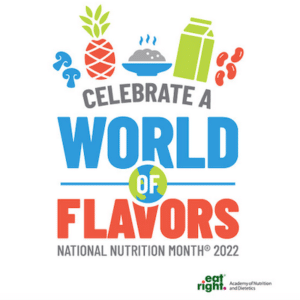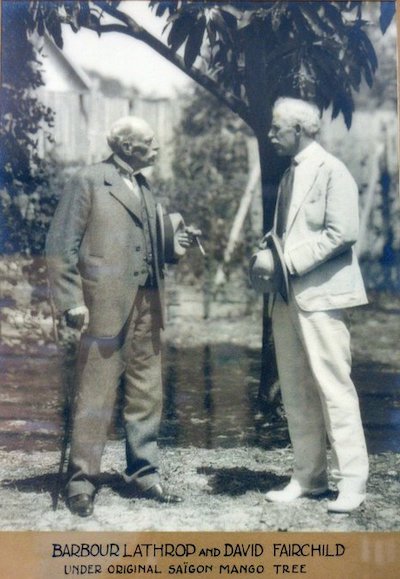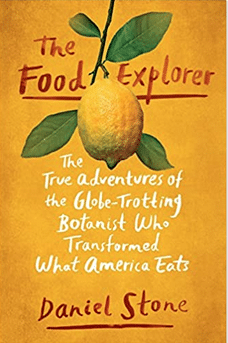
Step Back in Time
With today’s abundance of fruits and vegetables available to us, it’s hard to imagine the American diet was so bland in the 1800s. According to historians, America lacked a culinary identify as their diet centered on foods brought from England. Meats (mainly pork), cheeses and grains populated plates at mealtime. Even though the English arrived with carrots, barley and wheat, the variety of fruits and vegetables were limited compared to European and Middle East countries. In fact, it’s reported that “all things that sprouted from the soil was dubious to medical authorities” as it was perceived that woody tissue was harder to digest than animal muscle.1 Likewise, farmers were not enthusiastic about planting new crops that were perceived as a financial risk. The country needed David Fairchild.
Thank David Fairchild

The Changing Landscape and Palate
David Fairchild’s curiosity changed the landscape of America agriculture. It took two years of plant exploration before the U.S. Department of Agriculture (USDA) officially recognized his work as part of the department. Finally, by 1898, with USDA support and continued financial backing of Lathrop, the race was on to diversify America’s farmland. During Fairchild’s years of traveling the world, thousands of crops were introduced to American farmers and consumers.1

Fairchild and Lathrop under a mango tree in Saigon. Photo courtesy of the David Fairchild Collection, Fairchild Tropical Botanic Garden
Crops such as watermelons and avocados from Chile, soybeans from Indonesia, wheat from Spain, peaches from China, and kale from Croatia are just a few of the plants that tolerated the “new world” climate and were embraced by consumers and farmers. Likewise, Fairchild’s discoveries at a Venice café of broccoli and the more popular “raisin” red seedless grapes have populated gardens and California hillsides, respectively, for more than a 100 years.
While Fairchild’s plant introductions produced more successes than failures, America’s climate didn’t always comply. For example, the cashew was popular when introduced but the ability to grow the nut domestically was a challenge. It was soon discovered that Florida was the only tropical climate where the nut could be grown but even there agricultural challenges outweighed the benefits.1 Hence, cashews became an import crop early in the 1900s from India — a trade practice that continues today. With Fairchild’s introduction of new fruits and vegetables, the agricultural landscape of America and the world was forever changed. A global food economy was born.
The Global Economy and Crisis

With the current conflicts in Russia and Ukraine, markets will change and food insecurity will climb especially in the poorest countries. The prices of corn, wheat, barley and sunflower oil already have escalated. Countries like Egypt and Turkey — once the mecca of discovery for Fairchild — are experiencing the biggest disruptions. For example, Turkey processes the imported wheat and sunflower seeds to produce pasta, flour, oil and other foods, and sells these products to the Middle East and Africa.8 Unfortunately, many of those countries are already food insecure. Rising prices will only add to the challenges.
A World of Flavor
What originally started as a philanthropic endeavor of an inquisitive young botanist over a century ago has forever changed what America grows and eats … as well as our global economy. As we celebrate “ a world of flavors” this month, may we be reminded that our zeal for variety and taste extends beyond our borders. All things local are truly global.
References
1. The Food Explorer: The True Adventures of the Globe-Trotting Botanist Who Transformed What America Eats, Daniel Stone. New York, New York. Dutton, an imprint of Penguin Random House; 2018.
2. Barbour Lathrop, Wikipedia Page.
3. “U.S. Agricultural Trade Data Update,” U.S. Department of Agriculture Economic Research Service. Accessed August 30, 2021.
4. “U.S. Soy Works with Global Partners to Access Innovations and Markets,” U.S. Soybean Export Council. Accessed September 2, 2021.
5. “Wheat Sector at a Glance,” U.S. Department of Agriculture Economic Research Services. Accessed September 2, 2021.
6. “U.S. Dairy Exports, Top 10 Markets 2020,” U.S. Dairy Export Council. Accessed September 2, 2021.
7. “Tree Nuts,” U.S. Department of Agriculture Foreign Agricultural Services. Accessed September 2, 2021.
8. “War is driving up food prices, exacerbating shortages abroad, especially for food-insecure nations,” by Laura Reiley, Washington Post, March 11, 2022. Updated March 14, 2022.
Resources
Want to Know More About David Fairchild? Here are a few resources:

“This man is why American dinners don’t suck,” by Ron Hogan, New York Post, February 17, 2018.
“Man who changed what we eat,” by Daniel Neman, St. Louis Post-Dispatch, March 20, 2018.
